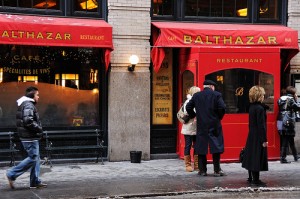How Does that Steak Frites Happen?
If you want to remind yourself what a really good magazine article can be, check out Willy Staley‘s N.Y. Times Magazine piece “22 Hours in Balthazar.” Balthazar is a SoHo restaurant that’s been around long enough to be an institution but is still good enough to inspire devotion from scene-setters, tourists, and locals alike. How?
That’s the question the article (and photographs) answer, in an elegant and fact-filled manner. For instance:
For now, everything is quiet at Balthazar. The last guests from the night before left just a few hours ago, and the nighttime porters are still finishing their thorough scrub of the restaurant. But the delivery trucks are starting to arrive all over again, idling on Crosby. Men in lifting belts wheel hand trucks stacked high with food from across the globe: 80 pounds of ground beef, 700 pounds of top butt, 175 shoulder tenders, 1 case of New York strips, all from the Midwest; 5 pounds of chicken livers, 6 cases of chicken bones, 120 chicken breast cutlets; 30 pounds of bacon; 300 littleneck clams, 110 pounds of mussels from Prince Edward Island, another 20 pounds from New Zealand, 50 trout, 25 pounds of U10 shrimp (fewer than 10 pieces per pound), 55 whole dorade, 3 cases of escargot, 360 Little Skookum oysters from Washington State, 3 whole tunas, 45 skates, 18 black sea bass, 2 bags of 100 to 120 whelks, 45 lobster culls. That’s just the fish and meat order.
And:
When the first party sits down, a waitress takes their coffee order, turns around and heads straight to a computer terminal. Balthazar’s waiters — like waiters at most restaurants — spend a lot of time doing the seemingly duplicative work of punching orders they have already written down onto touch-screen computers. The point-of-sale terminals (or P.O.S., as the occasionally vexing machines are known) remove a certain degree of human error, but more important, they keep waiters on the floor, selling food and booze, turning tables as efficiently as possible. Food runners bring the plates to the dining room; busboys take them back to the dishwasher. There is a coffee runner whose sole task is to bring coffee from the barista to guests. For the most part, a waiter’s job is to manage the flow of plates around the restaurant. As Wendt explains, “Anything that we can do to keep the waiters on the floor more, we do.”
And:
By the end of the day, the rotating staff of six cooks behind the line will have produced 111 steak frites, 90 French onion soups, 88 Balthazar bar steaks, 69 burgers, 68 omelets, 62 goat-cheese tarts, 56 chicken paillards, 51 chicken clubs, 48 seared salmon fillets, 46 heirloom-tomato salads, 45 sides of fries, 44 chicken-liver-and-foie-gras mousses, 43 duck confits, 40 grilled dorades, 39 steaks au poivre, 39 eggs Norwegian, 38 steak tartare appetizers (plus 16 entrees), 32 escargot, 32 moules frites, 29 grilled trout — the list, pulled from the P.O.S. terminals, goes on and on and on. The volume benefits the whole staff. Tonight, the waiters earn $345 in tips, the runners $207 and the busboys $172, which does not include the $5 an hour Balthazar pays them.
It is hard for me to say exactly why Staley’s article is so satisfying. It is fun, of course, to read about food, and it is always nice to have numbers in your journalism. If I had to name one “lesson” the article imparts, it would be a three-parter:
- Quality (still) counts; but:
- Quality doesn’t happen by accident;
- It is the product of a great deal of planning, hard work, marginal improvements — and, sure, a little bit of luck.


Comments